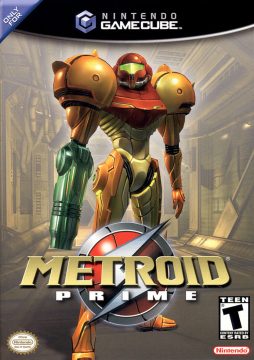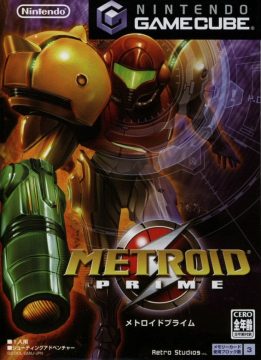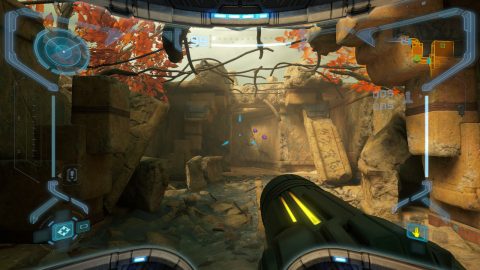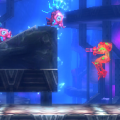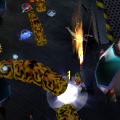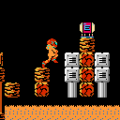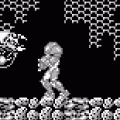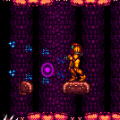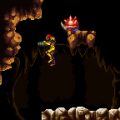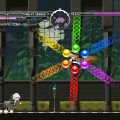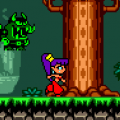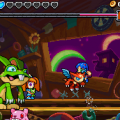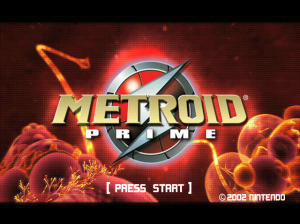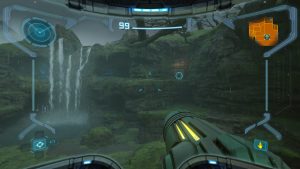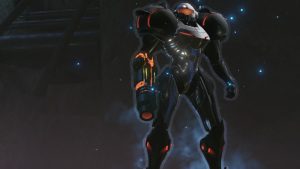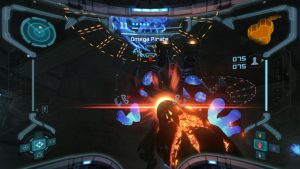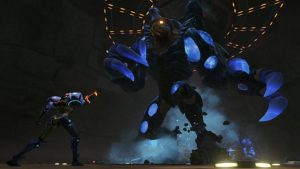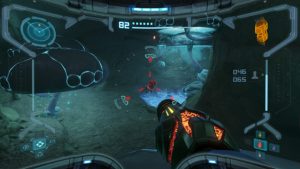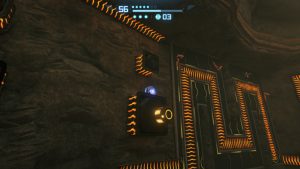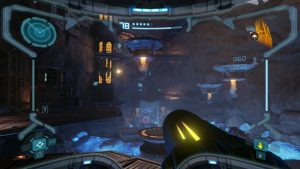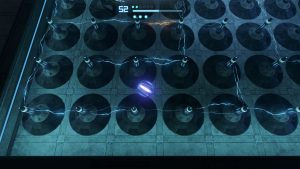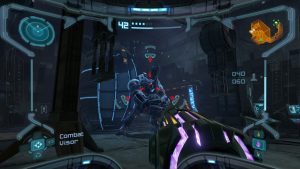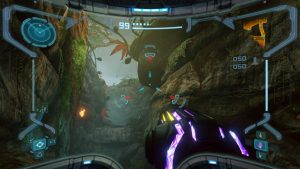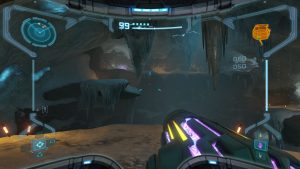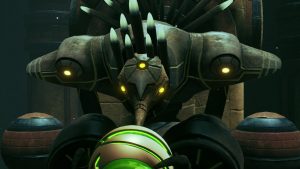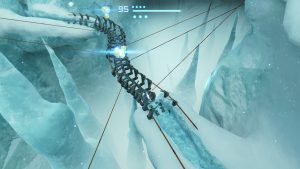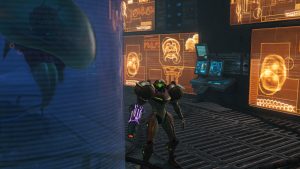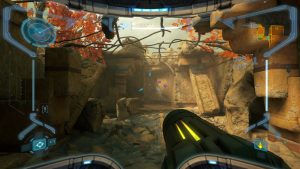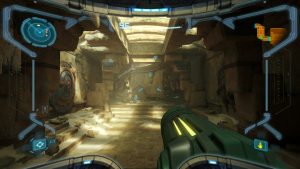The entirety of the Metroid series is covered in HG101 Digest 7: Metroid and Kid Icarus, please check it out!
Despite the widespread acclaim of Super Metroid, the series took a leave of absence during the Nintendo 64 era. Perhaps to make up for this, Nintendo planned for two brand new games to be released in late 2002, with a 3D one for the GameCube called Metroid Prime, developed by the Texas-based Retro Studios; and a 2D title for the Game Boy Advance called Metroid Fusion, developed in Japan. There was quite a bit of doubt over the 3D entry – Retro Studios had some staff from Iguana Entertainment, who had previously developed two of the Turok games for the Nintendo 64, but hadn’t released any games at all in their then-current incarnation. As first-person shooters like Halo were extremely popular at the time, there was also plenty of concern that the series would abandon its exploratory roots in favor of action. In the end, all fears were immediately allayed upon release where, curiously, the 3D Prime ended up being more faithful to the series’ roots than the 2D Fusion.
Chronologically, the Metroid Prime series takes place between the first and second Metroid games. The first entry begins similarly to Super Metroid, with Samus answering the distress signal of a vessel orbiting the planet Tallon IV. This opening segment acts as both a prologue and a tutorial, allowing the player to accommodate themselves with the new first-person perspective and controls. Once again there’s an encounter with Ridley, now taking on a cybernetic form, and once again, the ship begins to self-destruct as Samus tries to escape. She takes some damage in the process, removing many of the special abilities of her suit (providing an in-game explanation as to why she keeps losing her powers and must regain them). Upon reaching her ship, she chases Ridley to the surface of Tallon IV and begins her search.
 Nintendo and Retro were keen to address some of the regular issues with first-person shooters of the era. Primarily, in many of these games, it doesn’t really feel like you’re controlling an actual character, but rather just a floating gun. To that end, Metroid Prime works overtime to make it feel like you are truly inhabiting the Power Suit of intergalactic bounty hunter Samus Aran. The perspective here includes her visor, which displays the health meter, a missile gauge, a radar, and a minimap. Not only is it a clever bit of UI design, but it’s also incredibly immersive – the visor mists up when you approach steam or water, and bits of alien goo will splatter on it if you kill an enemy up close.
Nintendo and Retro were keen to address some of the regular issues with first-person shooters of the era. Primarily, in many of these games, it doesn’t really feel like you’re controlling an actual character, but rather just a floating gun. To that end, Metroid Prime works overtime to make it feel like you are truly inhabiting the Power Suit of intergalactic bounty hunter Samus Aran. The perspective here includes her visor, which displays the health meter, a missile gauge, a radar, and a minimap. Not only is it a clever bit of UI design, but it’s also incredibly immersive – the visor mists up when you approach steam or water, and bits of alien goo will splatter on it if you kill an enemy up close.
Other first-person shooters like Halo and Doom never really leave the perspective of the characters, so weirdly, you never actually get to see protagonists like Doomguy or Gordon Freeman unless you’re looking into a mirror. In contrast, Metroid Prime regularly takes the camera outside of Samus’ view to give a cinematic look at the action, typically in the form of cutscenes than pan around and introduce new areas. The camera also changes to a third-person perspective when using the Morph Ball, giving you a wider view of the terrain as you roll around.
 A few other first-person shooters of the time attempted platforming, like the planet Xen at the end of Half-Life, and no one had anything nice to say about them. Metroid Prime, again, tries something different in making platforming a significant part of the experience, since it was so intrinsic to the 2D games. Samus’ movement is keenly attuned to allow you to easily jump from platform to platform, moving at a speed that’s easy to control and helpfully tilting her head slightly downwards in mid-jump. It’s a little tough to get a hold of at first, since, unlike other 3D games, you can’t use a shadow to approximate where you’ll land, but the landscapes are also constructed to make it as easy as possible. You also get the Space Jump early on in the game, which effectively acts as a double jump in the Prime series, making traversal almost effortless. There’s even a little gauge on the visor which detects the proximity of environmental hazards.
A few other first-person shooters of the time attempted platforming, like the planet Xen at the end of Half-Life, and no one had anything nice to say about them. Metroid Prime, again, tries something different in making platforming a significant part of the experience, since it was so intrinsic to the 2D games. Samus’ movement is keenly attuned to allow you to easily jump from platform to platform, moving at a speed that’s easy to control and helpfully tilting her head slightly downwards in mid-jump. It’s a little tough to get a hold of at first, since, unlike other 3D games, you can’t use a shadow to approximate where you’ll land, but the landscapes are also constructed to make it as easy as possible. You also get the Space Jump early on in the game, which effectively acts as a double jump in the Prime series, making traversal almost effortless. There’s even a little gauge on the visor which detects the proximity of environmental hazards.
Because of your movement capabilities, the rooms in Metroid Prime have much more verticality than most other first-person shooters, which also works to make the world feel much more three dimensional. They’re also finely crafted, down to even the smallest details – there’s almost never such a thing as a flat wall, as each area is designed with angles and outcroppings that make navigating the environment feel remarkably organic. It also keeps a buttery smooth 60 FPS most of the time, and it’s astounding that the game both looks and feels fantastic to play. Load times are minimal too – outside of the elevators, which act as transitory scenes between major areas, all of the data is streamed off the disk. Just beware that early releases of the GameCube version have a bug where if you run through a tunnel too fast and try to open a door to the next room, the game may freeze up.
The controls are a bit non-standard though, at least in the GameCube version. While most console-based first-person shooters of 2002 had adopted the dual-stick control scheme used in games like Halo, Metroid Prime only uses a single analog stick for movement, and instead the C-stick is used for selecting weapons. The R shoulder button is not only used for strafing, but is also to lock onto enemies, allowing you to both circle strafe and more easily target them. It may sound unusual, but it’s basically the same set up as The Legend of Zelda: Ocarina of Time, only implemented from the first-person perspective. The only real hiccup comes from the dual function of the B button – normally, this is the jump button, but when you tap it when you’re moving and locked on, it’ll make Samus dash. This is extremely useful for avoiding attacks in boss fights, plus many enemies are only vulnerable from behind or the sides, so you can quickly move into attack position. However, it’s also very easy to tap the button too strongly, which means you’ll jump rather than dash, potentially screwing up your maneuvers.
The 2009 version featured on the Metroid Prime Trilogy release instead features Wii Remote controls, giving you a more traditional control scheme that lets you move and look around independently. However, the lock-on function is still available and used in many fights, since the combat was originally designed around it. Even though the Wii supports GameCube controllers, you have to use the Wii Remote control scheme if you’re playing this version. The Remastered version on the Switch offers a standard FPS dual-stick control scheme.
Also unique to the Metroid Prime series is the Scan Visor, which lets you obtain information on enemies and other things in the environment. It’s a very different approach to storytelling compared to Metroid Fusion, which regularly included interior monologues by Samus, whereas in this game she never really speaks. Outside of giving hints on how to beat bosses or showing bits of scenery that can be destroyed, you can also read messages by the Chozo and logs by the Space Pirates. Much of these have to do with their experiments on the Metroid specimens found in their labs, but there’s also quite a bit of commentary on Samus and her suit, who they fear greatly. In one amusing log entry, they make note of how they tried to replicate her Morph Ball functionality, only for all of the test subjects to end up horribly mangled.
As far as weapons go, most of the usual ones return – Ice, Wave, and Plasma Beams, along with Super Missiles and Super Bombs. In addition to the Scan Visor, there are also Thermal and X-Ray Visors, which let you see in the dark or view things that wouldn’t normally be visible, among other things. There’s also the Grappling Beam, though the Screw Attack is missing, as the developers couldn’t figure out how to get it working, though it’s a problem they solved in the sequel. As with Super Metroid, the Varia Suit increases defense while the Gravity Suit lets you maneuver in water, and the new, stylish Phazon Suit decreases radiation damage. There’s also the super powerful Phazon Beam, but this is only usable in the final battle.
Easily the most fun of the upgrades is the Morph Ball. It was always a weird and unusual function in the 2D Metroid games, but here, the physics are completely different from when you’re walking about, and it’s a lot of fun to just roll around the scenery. There are also a few half-pipes where you can use the Boost function to build up momentum as you roll back and forth, eventually propelling you to greater heights. The Spider Ball from Metroid II returns as well, though it’s only usable on specific tracks, rather than just latching onto any surface. There are plenty of little mazes that are presented from a side-view perspective too, and it’s fun to see the way the tracks and tunnels twist all over.
Tallon IV is divided up into several areas with different biomes. You begin on the rainy Overworld, an area similar to Crateria and Brinstar, which is overrun by plant life and other vegetation. Early on you also explore the Chozo Ruins, the remains of the ancient civilization that created Samus’ Power Suit, and mostly sits in an area filled with sand and rocks. Magmoor Caverns is an underground series of tunnels filled with lava and is basically this game’s equivalent to Norfair, while the Phendrana Drifts present an arctic climate buried in snow and ice, as well as being the home of a Space Pirate research facility. Like Super Metroid, there’s also a ship wreckage to explore, except this one is the Frigate Orpheon, the same vessel you explored in the game’s prologue, which is now partially submerged in water. There are the Phazon Mines as well, a mountainous area where the Space Pirates set up operations to collect the energy source called Phazon, which is a recurring theme throughout the Prime subseries.
As with previous games, you’ll be sent back and forth across these areas, gathering power-ups to expand Samus’ movement capabilities to access new areas. The ultimate goal is to gain entrance to the Impact Crater, the site of a meteor crash from long ago, where you’ll face off against the final boss, the titular Metroid Prime. Additionally, you’ll need to hunt for twelve Chozo artifacts scattered around the planet before you gain entry. If you know what you’re looking for, you can collect these as you journey around, but if you’re playing for the first time without a guide, you’ll probably spend the last part of the game following the hints left by the Chozo and retracing your steps.
The end-game hunt is also a good time to search for all of the energy tank and missile upgrades you weren’t able to reach the first time around. In Super Metroid, this felt like an optional step since the game was so easy that you didn’t really need to build up yourself that much. Not so with Metroid Prime, which is far more challenging, and you’ll need everything you can get in the climactic final encounters. The Game Over scenes in the Metroid Prime games are some of the most harrowing seen in a Nintendo franchise – in this game, the camera focuses on Samus’ broken visor while a heart beat monitor beeps loudly, indicating that life support systems are failing, before it flatlines and quietly requests that you reload a previous save. It’s shocking every time you see it!
The boss fights are similar to those found in the 3D Zelda games, where you need to avoid a pattern and look for openings until you find a weakpoint, then exploit it. While they’re well-designed, the boss monsters themselves are a little underwhelming, and serve as one of the game’s only sore points. Of the more notable ones, there’s a large plant creature called the Flaahgra, a being made of rocks called Thardus, and an enormous Omega Pirate. Ridley pops up again near the end in his robotic form as Meta Ridley, and the design of the eponymous Metroid Prime in the climactic final battle is pretty cool.
Partially because navigating 3D environments takes so much more time than 2D ones, and also due to the artifact hunt, Metroid Prime is quite a bit longer than most of the 2D entries, with an average playthrough taking between 12-15 hours. It can be very easy to get lost the first time you play, and while the map is extremely helpful, since it’s a 3D wireframe, it’s something you really need to sit down and study. A hint function will at least point you in the right direction (though not necessarily tell you how to get there) if it detects that you’re wandering around for too long.
The soundtrack is one of the few elements provided by the Japanese team, and was composed by Koichi Kyuma and Kenji Yamamoto, the latter of whom also worked on Super Metroid. While some classic themes are rearranged here (the Magmoor Caverns track is basically identical to Norfair’s theme), the style is a little different, less melodic and more subdued. But it’s also perfect for the atmosphere, particularly the piano in the Phendrana Drifts area. The title screen is an extreme close-up of a Metroid accompanied by the game’s main theme, which perfectly sets the stage for the game. Curiously, the disc’s files have a voiced introduction by Samus, played by famous voice actress Jennifer Hale. This was never used in the game though, and Samus didn’t end up speaking aloud until Metroid: Other M, several years later.
It’s almost shocking at how good Metroid Prime turned out, especially considering how green Retro Studios was – nearly every element is expertly crafted. The visuals are beautiful, and combined with the smooth framerate and sparse loading, it shows a game that was way ahead of its time in 2002. Outside of the standard definition visuals, it barely feels dated at all. The environments are brilliantly crafted, presenting a world that feels lived in, with finely tuned controls that make them a joy to explore. It’s just a fantastic game, and easily one for the annals of history.
There have been several revisions of Metroid Prime, mostly to tune up various bugs and remove glitches that allow for sequence breaking. The first instance was released in late 2002 in North America on the GameCube. The PAL and Japanese versions tuned things up, and were later imported back into North American prints. There are also small differences and tweaks too, like added voices for Samus’ suit (for when it records scanned data into your log book and such), as well as some different lore text. The Japanese version also has a male voice that announces the names of the different sectors when reloading a saved game and provides other bits of narration, which pops up sporadically in the European version.
The game was released separately in Japan on the Wii as part of the New Play Control line, and compiled into the Metroid Prime Trilogy release in North America and Europe. This version uses controls tailored especially for the Wii Remote, and they’re basically identical to the scheme used in Metroid Prime 3. In addition to including most of the bug fixes and tweaks up to this point, and support for 16:9 widescreen, it features difficulty changes that make it quite a bit easier, as well as other small additions like the Spring Ball, allowing you to jump in ball form without the need to use bombs. However, it’s missing the eerie title screen in favor of a menu for all three games, and there are a few minor graphical effects missing, like the condensation when charging the Ice Beam.
The Remastered release for the Switch in 2023 updates the graphics to HD, with tuned up level geometry and textures, resulting in a game that looks shockingly modern despite being over two decades old. Also added are standard FPS dual-stick controls and other minor tweaks, like the ability to enable the voices and narration from Japanese version.

